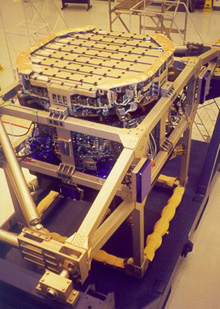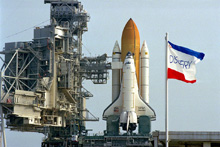

The AMS spectrometer installed in its support structure.

The official NASA logo of the STS-91 mission, June 1998. The Space Shuttle and the MIR Space Station are recognizable, along with the AMS experiment receiving particles in its cylindrical volume.
The Space Shuttle Discovery on the Launch Pad before liftoff for the STS-91 mission. Nasa, Kennedy Space Center, June 1998.
AMS
(by Davide Vite')
About 15 billion years ago, matter and antimatter were created in a gigantic Big Bang in equal amounts, at least according to today's best theory. It is therefore surprising that our Earth, the solar system, and our galaxy (the Milky Way) do not contain any antimatter.
To explain this absence, scientists have come out with two possibilities: either antimatter completely disappeared during the history of universe, or matter and antimatter have been separated from each other to form different regions of the universe.
In the second case, we would be located in a region where only matter exists (or rather what we call 'matter'), but some antimatter coming from an 'anti' region outside our galaxy could still have a chance to reach us. This antimatter would be in the form of anti-nuclei (like anti-Helium, anti-Carbon, etc..) as opposed to lighter antiparticles (such as antiprotons) which are also created in high energy collisions between ordinary matter. To search for this extragalactic antimatter, the best way is to place a particle detector in space.
A world-wide collaboration of physicists, lead by Nobel prize laureate Prof. Samuel Ting of MIT, decided to build the 'Alpha Magnetic Spectrometer', or AMS. AMS is a high energy particle detector which will try to detect the passage of such very small amounts of antimatter, while orbiting at an altitude of a few hundred kilometers above the atmosphere.
Some of the main challenges of the project are very technical: having to be carried on the Space Shuttle, each component of the apparatus has to be miniaturized as much as possible to keep the total volume to a maximum of 10 cubic meters and the weight to a maximum of 3 tons (a typical high energy apparatus at LEP with the similar detecting principles is about 1000 cubic meters in volume and 100 tons in weight).
Even more important is the power consumption: AMS should not need more than 2 kW (kilowatts) of electricity, provided by the solar panels of the Space Station. And 2kW is less than what a kitchen oven needs!


